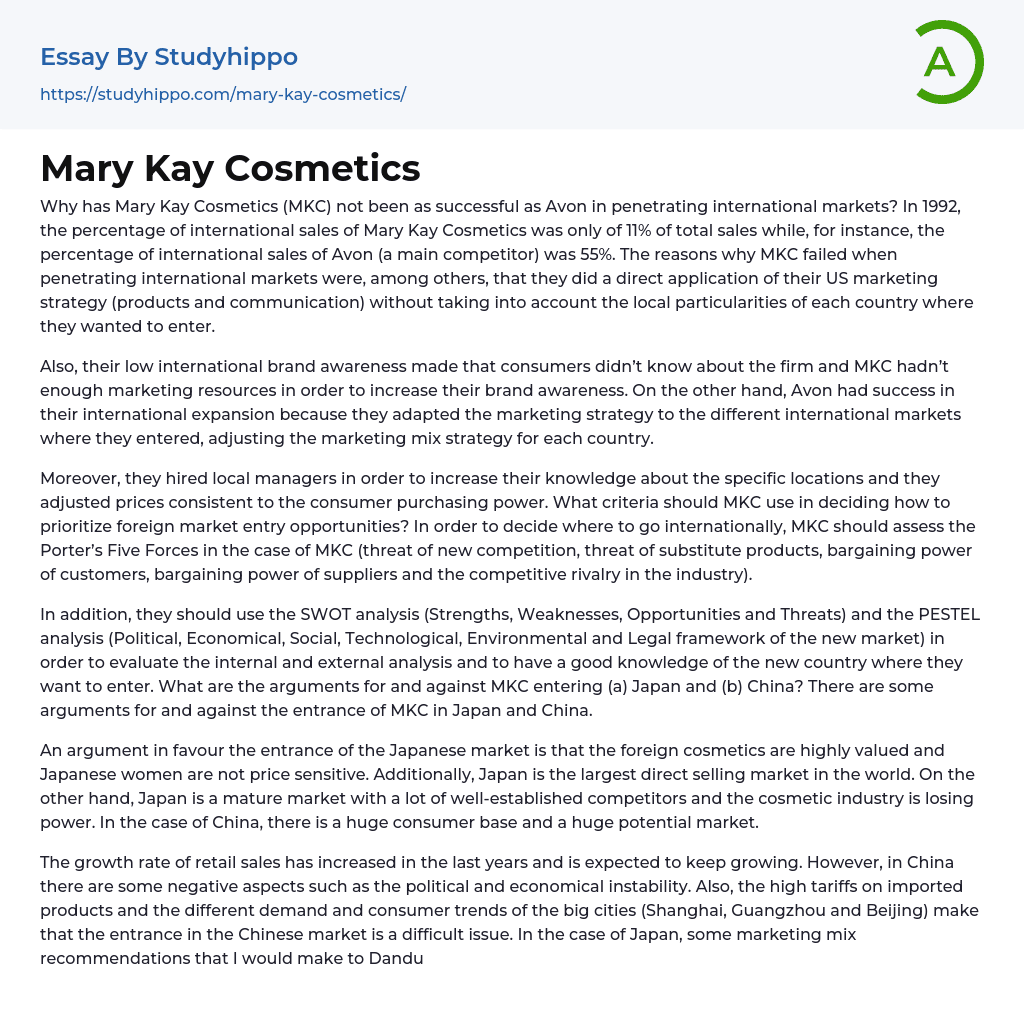Why has Mary Kay Cosmetics (MKC) not been as successful as Avon in penetrating international markets? In 1992, the percentage of international sales of Mary Kay Cosmetics was only of 11% of total sales while, for instance, the percentage of international sales of Avon (a main competitor) was 55%. The reasons why MKC failed when penetrating international markets were, among others, that they did a direct application of their US marketing strategy (products and communication) without taking into account the local particularities of each country where they wanted to enter.
Also, their low international brand awareness made that consumers didn’t know about the firm and MKC hadn’t enough marketing resources in order to increase their brand awareness. On the other hand, Avon had success in their international expansion because they adapted the marketing strategy to the different international markets where they e
...ntered, adjusting the marketing mix strategy for each country.
Moreover, they hired local managers in order to increase their knowledge about the specific locations and they adjusted prices consistent to the consumer purchasing power. What criteria should MKC use in deciding how to prioritize foreign market entry opportunities? In order to decide where to go internationally, MKC should assess the Porter’s Five Forces in the case of MKC (threat of new competition, threat of substitute products, bargaining power of customers, bargaining power of suppliers and the competitive rivalry in the industry).
In addition, they should use the SWOT analysis (Strengths, Weaknesses, Opportunities and Threats) and the PESTEL analysis (Political, Economical, Social, Technological, Environmental and Legal framework of the new market) in order to evaluate the internal and external analysis and to have a good knowledge of the
new country where they want to enter. What are the arguments for and against MKC entering (a) Japan and (b) China? There are some arguments for and against the entrance of MKC in Japan and China.
An argument in favour the entrance of the Japanese market is that the foreign cosmetics are highly valued and Japanese women are not price sensitive. Additionally, Japan is the largest direct selling market in the world. On the other hand, Japan is a mature market with a lot of well-established competitors and the cosmetic industry is losing power. In the case of China, there is a huge consumer base and a huge potential market.
The growth rate of retail sales has increased in the last years and is expected to keep growing. However, in China there are some negative aspects such as the political and economical instability. Also, the high tariffs on imported products and the different demand and consumer trends of the big cities (Shanghai, Guangzhou and Beijing) make that the entrance in the Chinese market is a difficult issue. In the case of Japan, some marketing mix recommendations that I would make to Dandurand are, by what respects to the product, to introduce both skin care and make-up products. In the promotion, I think that MKC should advertise trough mass media and in the distribution issue, the best is to distribute through a combination of franchises, general distribution and door to door selling and also focus on selective distribution channels in order to give exclusivity to the product.
Last, MKC should establish high prices to their products to give a superior quality image. In the case of China, they should
introduce more skin care products because women are more interested in wrinkles products than in other products. They should advertise in the regional TV channels of the large cities, focusing in Shanghai because there is a higher market. They should sell their products in very exclusive stores very separated from domestic products. And they should adjust the prices to the real wages, which are lower than in the US.




